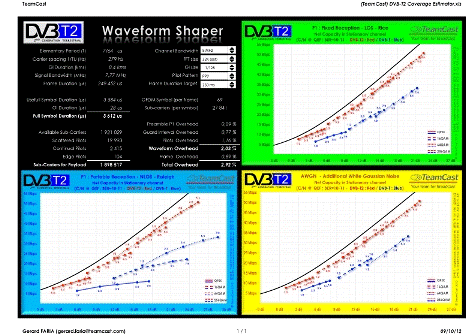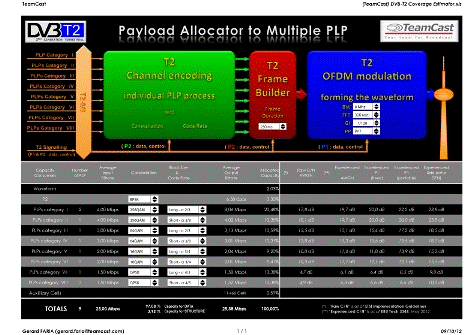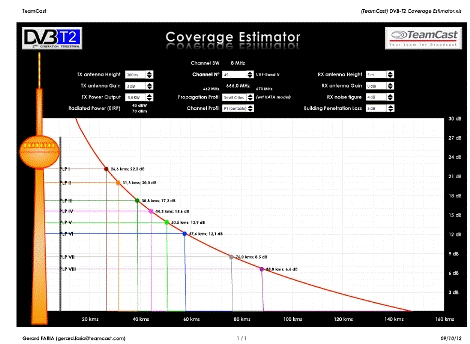DVB-T2 Calculator
In order to help DVB-T2 terrestrial network implementers, TeamCast has designed the « Universal DVB-T2 Calculator » which provides an easy way to adjust step-by-step the various sets of parameters and to weight the obtained results.
The DVB-T2 European Norme (ETSI EN 302 755 v131 (2012-04) is on-air since four years and it will become soon the worldwide preferred Digital Terrestrial Broadcast system.
DVB-T2 exhibits a « close-to-Shannon» spectral efficiency sustained by an extreme flexibility that provides an optimum response to the various requirements of broadcasters around the world. As a consequence, DVB-T2 offers thousands of possible configurations which involve multi-PLP and flexible framing (FEF), etc.
In order to help network implementers, TeamCast has design the « Universal DVB-T2 Calculator » which provides an easy way to adjust step-by-step the various set of parameters and to weight the obtained results.
The « Universal DVB-T2 Calculator » is made of three folders: Waveform Shaper, Payload Allocator and Coverage estimator.
The T2’s Waveform Shaper
This folder allows to define the parameters of the T2 waveform (channel bandwidth, FFT size, GI size, Pilot Pattern and T2 frame duration), which govern the maximum transmission capacity.

The « waveform overhead» coming from the Preamble P1, the Guard Interval and the Pilots, which consumes some waveform capacity, is computed & displayed.
In addition to the technical parameters, the reachable T2’s transmission performance (i.e. bitrate versus robustness) is presented for three propagation channels (i.e. AWGN, FIXED (Line-Of-Sight) and PORTABLE (Non-Line-Of-Sight)) and can be compared with the DVB-T’s ones.
The T2’s Multiple PLP Allocator
This folder aims at distributing the transmission capacity between Physical Layer Pipes (PLP).
Up to 8 categories of PLP can be managed and for each category the following parameters must be defined: the average input bitrate, the number of PLP (in the category), the code rate & constellation (for this category).

According to these settings, the capacity allocated to each category of PLP is determined as the global capacity repartition between data & the T2 structure. Additionally, the C/N threshold (i.e. the robustness) of each PLP’s category is provided for various propagation channels:
The « Raw AWGN» column corresponds to the C/N values provided in the DVB-T2 Implementation Guidelines that result from simulations using Additional White Gaussian Noise channel model.
The « Experienced» columns corresponds to the C/N values revised according to EBU Tech 3348 which takes in account typical receiver’s implementation losses, then provides more realistic C/N threshold values.
The T2’s Coverage Estimator
This folder aims at estimating the expected coverage of each PLP category in relation with the transmitter characteristics, the receiver characteristics and the propagation environment.

The path loss between transmitting & receiving antennas is computed according to the HATA model, this model being relatively accurate in the UHF band for distance below 30 kms.
The « path loss» curve and the C/N threshold of each category of PLP are displayed giving an indication of the maximum distance at which such category could be received.
This path loss estimator shall not be considered as a planning tool: it is intended to provide a rough estimation, not an accurate coverage prediction.
For getting a free copy of the Universal DVB-T2 Calculator, as an MS Excel file, please fill in the form below and mention you wish to receive it.
You will promptly receive your own copy of the Universal DVB-T2 Calculator, for free, by email.
TeamCast declines all responsibilities for the usage of this evaluation tool. The accuracy of all data supplied by the evaluator tool is in accordance with the system implementation guidelines having the following references:
– ETSI TS 102 831 v1.1.1 (2010-10) for DVB-T2,
– ETSI TR 101 190 V1.3.1 (2008-10) for DVB-T.
